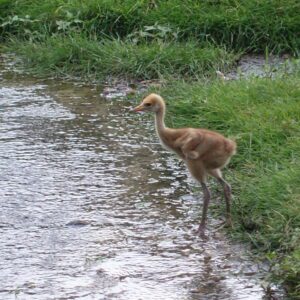Summary of July itinerary in Japan (Hokkaido)
From Saturday, July 2 to Monday, July 4, I traveled to Hokkaido (Kushiro and Akkeshi). On this trip, I was able to eat more seasonal seafood and local cuisine than on any previous trip. I was also able to enjoy the great national parks at Lake Akan and the Kushiro Marshland, as well as the wonderful flora and fauna, including nationally protected species like the marimo and the Japanese (tancho) crane.
Even in early July, when it was extremely hot in Japan, the temperatures in Kushiro and Akkeshi were 5 to 10°C cooler than in Honshu, making it the perfect summer vacation. I strongly recommend this itinerary for July in Japan. Here is a summary of the trip and some notes.
Table of contents
1.”100 best of local dishes” and “Local dishes loved by the nation” by this itinerary in Japan
2. Seasonal “PRIDE FISH” by this itinerary in Japan
3. Travel precautions for the itinerary in Japan
Again, each time, this itinerary was also created with the objective of “eating all the seasonal seafood and local cuisine”. Food is the top priority, with tourist attractions second. On this trip, I was able to eat more seasonal seafood and local cuisine than on any previous trip. Nevertheless, I aimed to visit as many tourist attractions as possible, including national parks and national important cultural properties.
1.”100 best of local dishes” and “Local dishes loved by the nation” by this itinerary in Japan
Hokkaido: Jingisukan
This time, I was able to eat Jingisukan from the “100 selections of local dishes” list. I ate Jingisukan at “Restaurant Tancho” at Kushiro Airport before flying out to Haneda Airport on the last day. Since it was an airport restaurant, I did not expect much, but the amount of food was large and the taste was delicious, and I was very satisfied with the Jingisukan.
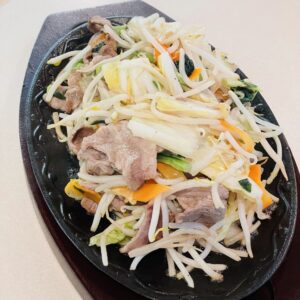
From “Our Regional Cuisines,” I could eat “Zangi.” However, what I ate was “Tako (octopus) Zangi” among “Zangi”. Usually, “Zangi” is fried chicken, but since I was full, I decided to eat “Tako Zangi” which was smaller in quantity. I also had “Tako Zangi” at Restaurant Tancho. It was a delicious “Tako Zangi”.
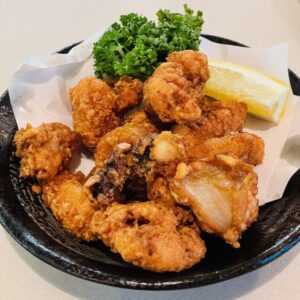
Although only “Jingisukan” and “Tako (octopus) Zangi” were available from “100 selections of local dishes,” “Local dishes loved by the nation,” and “Our Regional Cuisines,” I was able to eat many local dishes of Kushiro and Akkeshi. The list includes “Jaga Butter,” “Muryouju Soba,” “Kushiro Ramen,” and “Spag-Katsu (spaghetti cutlet). I wrote about seafood in “2. Seasonal “PRIDE FISH” by this itinerary in Japan“.
The “Jaga Butter” was an exquisite dish made from the rare Hokkaido variety “Inca no mezame.” Compared to regular potatoes, it is characterized by its high sugar content and bright yellow cross-section. Production of these potatoes is very small even in Hokkaido, and they are also called “phantom potatoes. In Hokkaido, especially in southern and eastern Hokkaido, people eat “Jaga Butter” with fermented squid products.

“Muryouju Soba” is a soba noodle with sesame oil called “Muryouju” and is a local delicacy in Kushiro. It was developed by “Chikuroen Azumaya Sohonten. Although it is made with sesame oil, it is not oily and tastes great.
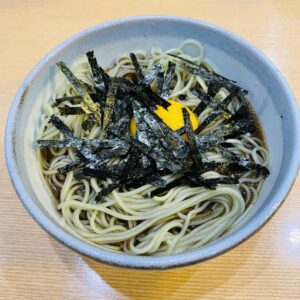
I had “Kushiro Ramen” at “Tsubuyaki Kadoya” and “Ramen Maruhira”. Kushiro ramen is characterized by its thin, curly noodles and light soy sauce-flavored soup. There is a movement among Kushiro residents to call Kushiro ramen one of the four best ramens in Hokkaido, along with Sapporo ramen, Hakodate ramen, and Asahikawa ramen, which are called the three best ramen in Hokkaido.
In particular, the soy sauce ramen at Ramen Maruhira is one of the top three soy sauce ramen I have ever had.
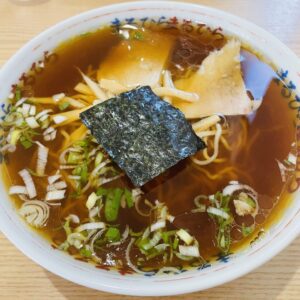
I had “Spag-Katsu”, a local dish of Kushiro, at “Restaurant Izumiya” in Suehiro-cho, downtown Kushiro. Spaghetti is a pork cutlet topped with spaghetti in meat sauce. It is served on a black teppan plate and is brought to the table with a sizzling sound. It seems that the dish was first served on a teppan plate so that it would not get cold even in the cold Kushiro. The restaurant that originated the spaghetti is “Restaurant Izumiya”.
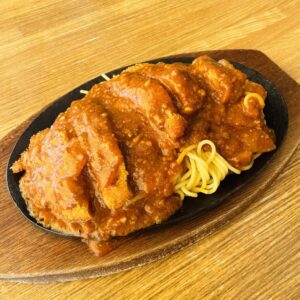
The “100 selections of local dishes,” “Local dishes loved by the nation,” and “Our Regional Cuisines,” were selected by the Ministry of Agriculture, Forestry and Fisheries.
2. Seasonal “PRIDE FISH” by this itinerary in Japan
Hokkaido: Akkeshi oysters (Season: May-August, December-February)
I could eat the seasonal “PRIDE FISH”, “Akkeshi oysters” this time. Oysters from Atsukishi are tasty from fall to winter, when the oyster’s meat becomes plump and delicious, but the area where oysters can be eaten in summer is limited to Atsukishi, where the seawater temperature is low all year round, so it was chosen as the summer “PRIDE FISH.
I had “Akkeshi oysters” at Oyster Bar Pitresk in “Conchiglie” in Atsugishi Taste Terminal with a glass of whiskey.
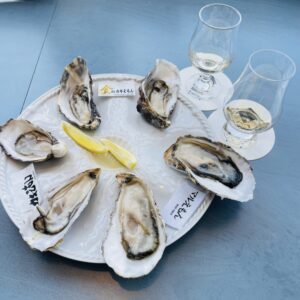
In addition to “Akkeshi oysters,” I could eat a wide variety of seafood including Hime-masu (kokanee), rainbow trout, wakasagi (pond smelt), gray rockfish, saffron cod, trout roe, whelks, scallops, and Sakhalin surf clams.
The grilled Hime-masu (kokanee) was very elegant, easy to eat, and delicious.

Rainbow trout (Akan salmon) farmed in Lake Akan are nurtured in the cold water that flows into the lake, and their meat is characterized by its firmness. As you can see in the photo, the rainbow trout sashimi was extremely fatty and tasted fantastic. I would say it was the best rainbow trout sashimi I have ever tasted. It was truly an impressive taste.
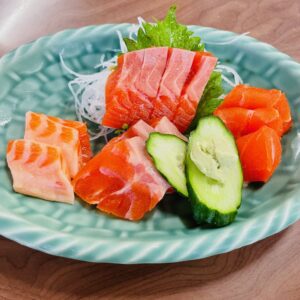
The Wakasagi (pond smelt) tempura from Lake Akan was also very tasty.
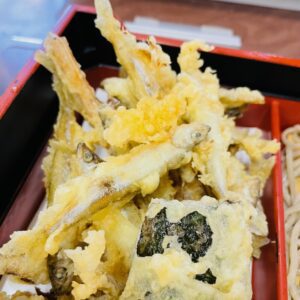
The “sashimi platter” I had in Kushiro included gray rockfish caught in Hokkaido. I was also impressed by the sweetness of the scallop sashimi.

This was the first time for me to try dried “Grilled saffron cod salted and dried overnight” and it was a masterpiece. The “Grilled saffron cod” I had this time was tender and had a wonderful taste with the concentrated flavor of fish under the ice.

“Masuko Oroshi” is a combination of rainbow trout roe and grated radish. Unlike salmon roe, there are not many opportunities to eat trout roe, so this was a rare opportunity.

The “tsubu-yaki,” grilled whelks, was an impressive taste. Tsubu-gai (whelk) are called “Hime-Ezo-Bora (Neptunea arthritica)” or “Ao-Tsubu” and are in season during the summer.
I was able to sit at the counter right in front of the grill. The sight of the chefs grilling dozens of whelks, checking the degree of doneness, and dipping them in the secret sauce was a true artisanship.
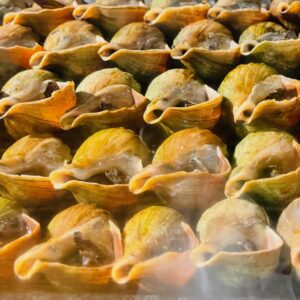
I had a sumptuous charcoal barbecue at “Charcoal Grill Aburiya” in Conchiglie. Grilled oysters, abalones, and scallops were also very tasty, but the most delicious dish of the day was the Sakhalin surf clam. I think the Sakhalin surf clam I had at “Charcoal Grill Aburiya” was from the eastern part of Hokkaido, as it was listed on the menu. They were thick, sweet, and irresistibly delicious.
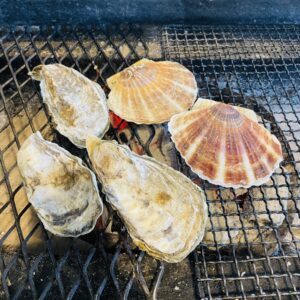
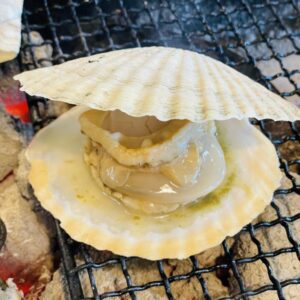
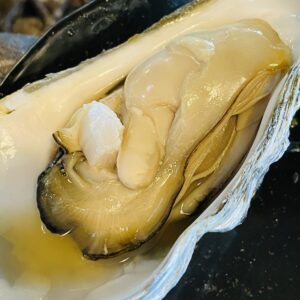
There is a theory that the name “Sakhalin surf clam” is derived from “north-producing shellfish” because they are abundantly harvested in Hokkaido. Hokkaido produces an overwhelming 90% of the nation’s Sakhalin surf clam.

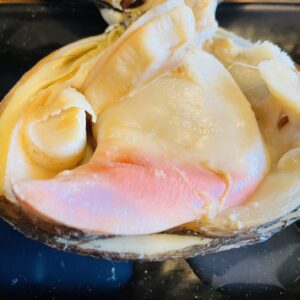
Among all of Hokkaido, Tomakomai produces the largest amount of Sakhalin surf clam, and Sakhalin surf clam is designated as “Tomakomai City Shellfish”. Tomakomai’s Sakhalin surf clam (season: July-November, December-April) is Hokkaido’s summer “PRIDE FISH” as selected by Japan Fisheries Co-operative. I had Sakhalin surf clam sashimi in Tomakomai last September. The sashimi was the best I have ever had in my life.
“PRIDE FISH” was selected by Japan Fisheries Co-operative.
3. Travel precautions (local trains) for the itinerary in Japan
I write the same thing every time, but I repeat it because it is important. Once again, the rules of the trip are that it is an environmentally friendly trip, using only public transportation, including bicycle rentals.
This is also a reconfirmation, but travel by public transportation emits far less CO2 than travel by car. For example, according to data from the Ministry of Land, Infrastructure, Transport and Tourism, CO2 emissions per person traveling 1km by air are 98g (75% of the amount for cars), 57g (44% of the amount for buses), and 17g (13% of the amount for trains), compared to 130g for cars.
I took the one-man-operated train again, but this time it was during the summer travel season, so there were many passengers and it was not difficult to understand how to get on and off the train. Outside of the travel season, the number of passengers decreases, and I think it will be difficult to understand how to get on and off the one-man-operated train. JR Nemuro Line” (I went from Kushiro Station to Akkeshi Station and back) was a one-man-operated train.
The train from Akkeshi Station to Kushiro Station was a Lupin the Third wrapping train. The author of “Lupin the Third”, Monkey Punch, is from Hamanaka Town in the Akkeshi-gun area along the Nemuro Line (Hanasaki Line), so the Lupin the Third Wrapping Train has been in operation since 2012 for regional revitalization.


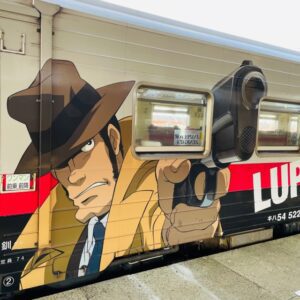
On one-man-operated trains, you must press a button to open the door when getting on and off the train. When boarding, passengers take a numbered ticket, and when getting off, they put the ticket and money in the fare box.
-e1658134282152-300x300.jpg)
There was a poster on the train about how to get on and off the train, but it was only in Japanese. Train operators and tourist associations should be responsible for providing information in foreign languages.
In the case of one-man-operated trains, it is safer to always ride in the first car. When traveling in rural areas of Japan, you should remember the rules for getting on and off trains. However, whether to ride from the front or rear door of the first car depends on the train operator.
Please see the detailed notes on each of the travel days.
4. Travel in a light style
Again, this is a recurring theme, but on this trip, I sent my clothes and power cord to my lodging in advance and enjoyed “luggage-free travel (empty-handed travel)” every day. After all, it is so much easier to travel dressed as lightly as if you were going for a walk. Being able to act immediately after arrival by train or plane is important for effective use of time.
On the last day of my trip, I sent the clothes I wore during the trip to a laundry service and did not have to do laundry. After checking out of the hotel and before going to the airport, I was able to view Japanese (tancho) crane chicks as much as I wanted at the Kushiro Japanese Crane Reserve because I did not have any luggage. I hope everyone will experience the comfort of “luggage-free travel”.
5. July 2 (Saturday) Day 1
I traveled to Kushiro City and Akkeshi City in Hokkaido for three days and two nights from July 2 (Sat) to 4 (Mon). Of course, we also delivered our luggage and enjoyed “luggage-free travel” on this trip.
Kushiro Airport is nicknamed “Tancho Kushiro Airport”. It is named after the red-crowned cranes that breed in the Kushiro Marshlands and other areas around Kushiro. A crane monument is placed at the bus stop after arriving at Kushiro Airport.
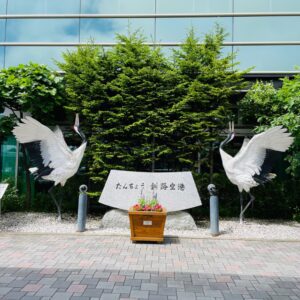
After arriving at Lake Akan, I immediately had lunch and went to Ainu Kotan. The main purpose of this trip to Hokkaido was to visit Ainu Kotan. Since our company’s trademark application for “NINJA KOTAN” was registered in July, I wanted to pay a courtesy visit to Ainu Kotan, from which Kotan (meaning “village” or “tribe” in the Ainu language) was borrowed. This was my first visit to Ainu Kotan in about 30 years since I visited there when I was a university student.
The entrance to the Ainu Kotan was the same as in the past, with a carved wooden Blakiston’s fish owl (Kotan koro kamuy = god who protects the village) perched there.
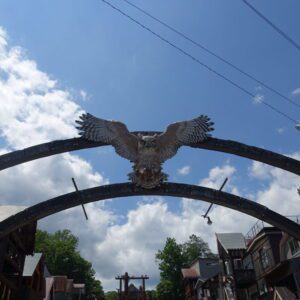
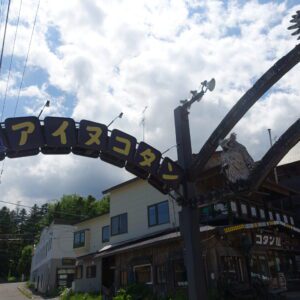
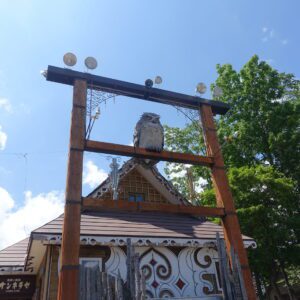
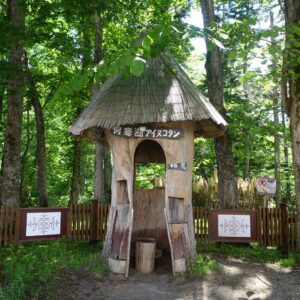
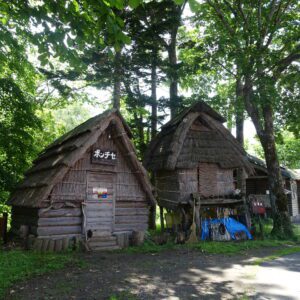
I went to Kushiro City Ainu Culture Museum “Onnechise” in Ainu Kotan. Onnechise is an Ainu art museum. In the Ainu language, onne means “big/near completion” and chise means “house”.
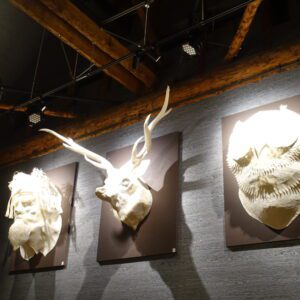
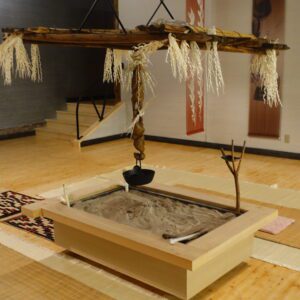
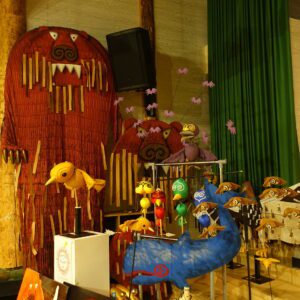
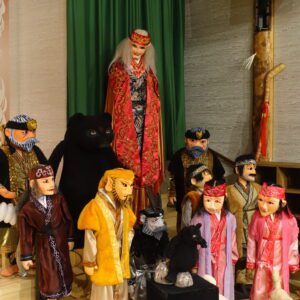
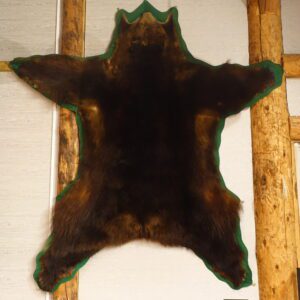
After visiting Ainu Kotan, I boarded the Lake Akan sightseeing boat. The weather was just perfect and I was able to fully enjoy Lake Akan. Lake Akan is a caldera lake with an area of 13.28 square kilometers, a circumference of 30 km, and a maximum depth of 45 meters.
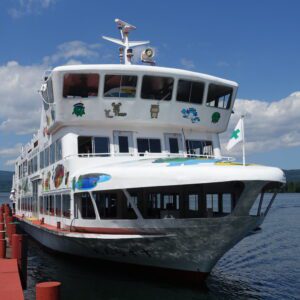
Around Lake Akan, there is Mt. Oakan dake, which is a little like Mt. Fuji. In addition, Mt. Meakan dake is an active volcano that still emits smoke and has been selected as one of Japan’s 100 Famous Mountains.
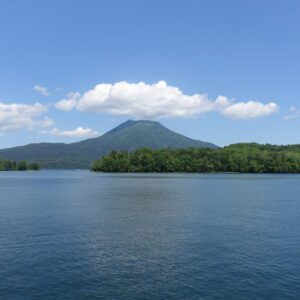
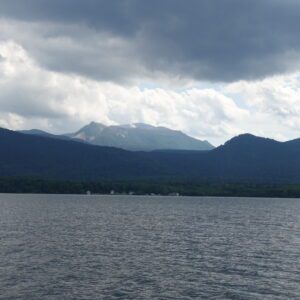
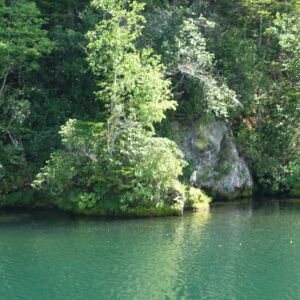
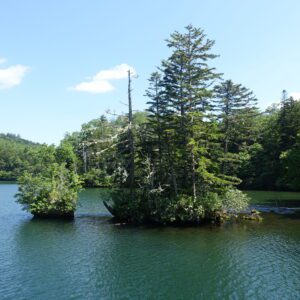
Lake Akan is home to marimo (lake ball), a nationally protected species (special national natural treasure), and Hime-masu (kokanee), a landlocked form of sockeye salmon. Lake Akan is famous for its marimo, and the Marimo Exhibition and Observation Center, where you can take a closer look at them, is a must-see. This facility is located on an island called Chu-Urui Island and cannot be visited by sightseeing boats or motorboats. The Marimo Exhibition and Observation Center also exhibited a giant marimo that was nearly 30 cm in diameter.

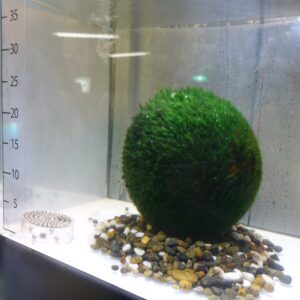
Marimo is a spherical aggregate of small thread-like fibers (filamentous bodies).
After enjoying the wonderful scenery of Lake Akan and the surrounding mountains and viewing the giant marimo at the Marimo Exhibition and Observation Center, I returned to Ainu Kotan to watch “Lost Kamuy” at the Ainu Theater. “Lost Kamuy” was created by combining ancient dance, modern dance, and 3D computer graphics, and using multiple projectors to create a three-dimensional stage.
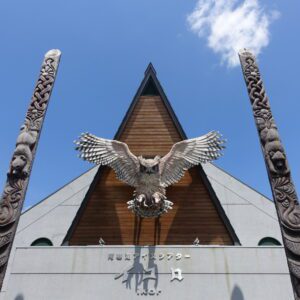
The story of “Lost Kamuy” centers on the extinct Ezo wolf. The Ezo wolf was called Horokeu kamuy, “the god of hunting,” by the Ainu people. The dance performed by the woman who played the role of Horokeu kamuy was magnificent. Photography is not allowed inside the hall.
Ancient Ainu dance, a UNESCO Intangible Cultural Heritage, is also performed at the Ainu Theater.
It was still light when we arrived in Kushiro city, but it was dark after dinner around the Nusamai Bridge. Many fishing boats were parked on the quay next to Kushiro Fisherman’s Wharf MOO.
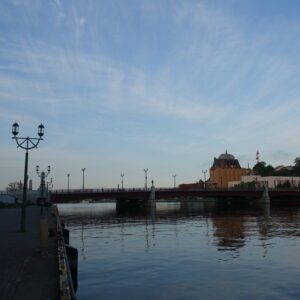
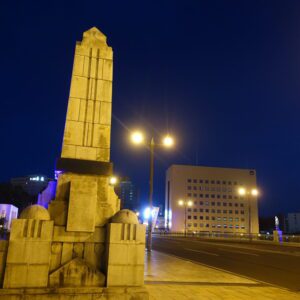

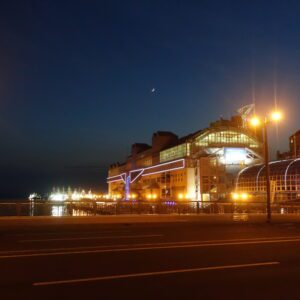
The name of the Nusamai Bridge is derived from the Ainu word “Nusa o mai” (where the place of mint is located). A mint is a place where inau (wooden staffs) are erected and lined up to worship the gods, and where rituals and other ceremonies are held. The Nusamai Bridge was beautifully illuminated in two colors at night. There was a character monument of “KUSHIRO” near the Nusamai Bridge.
橋黄色照明-e1657265344519-300x300.jpg)
橋青照明-e1657265372435-300x300.jpg)
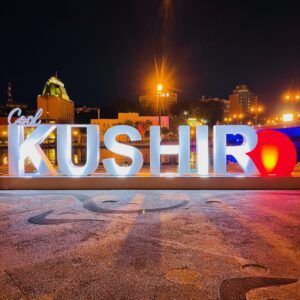
After dinner, I saw an Ezo red fox near Kushiro Station on the way back to the hotel from Nusamai Bridge. I was quite surprised to see an Ezo red fox in front of Kushiro Station, not in the mountains. This was the only time I saw an Ezo red fox on this trip.
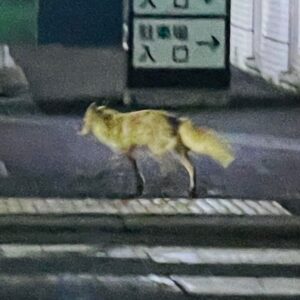
Meals
Our first meal on this trip to Hokkaido was at NabeKyu, a local restaurant in Lake Akan.
My main goal at “Nabekyu” was sashimi of Lake Akan’s specialty, Hime-masu (kokanee), which is only available from May to July. However, in 2022, the Hime-masu fishing season ended a few weeks in May, and no sashimi was offered. It was a pity because I visited Lake Akan with the top priority of Hime-masu sashimi. However, grilled Hime-masu was on the menu, so I ordered it. The grilled salted Hime-masu had a very elegant taste and was very easy to eat.

Hime-masu is a landlocked form of Sockeye Salmon. In the Ainu language, it is called kapacep. It is native to Lake Akan and Lake Chimikeppu (Abashiri County, Hokkaido).
Since I was unable to try the sashimi of Hime-masu, I ordered the sashimi of rainbow trout (Akan salmon) as an alternative. Rainbow trout are farmed in Lake Akan. I would say it was the best rainbow trout sashimi I have ever tasted. It was truly an impressive taste.

The tempura of wakasagi (Japanese smelt) caught in Lake Akan was also very tasty.

All the meals at “Local Cuisine Nabekyu” were superb, and it was very understandable that this restaurant is so popular and famous. If I have the chance to visit Lake Akanko Onsen next time, I will stop by this local cuisine restaurant.
After returning to Kushiro City from Lake Akan, I had dinner at Izakaya Buu on the second floor of Kushiro Fisherman’s Wharf MOO.
At Izakaya Buu, I ordered “Assorted Sashimi”, “Morokyu (A cucumber and unrefined miso)”, “Grilled saffron cod salted and dried overnight”, “Grilled Asparagus with Butter”, “Masuko Oroshi (Trout roe with grated daikon radish)”, and “Jaga Butter (potato with butter)”.

The “sashimi platter” included Gray rockfish, greater amberjack, tuna red meat, rainbow trout, scallops, and whale. I was especially impressed with the sweetness of the scallop sashimi.

I had never tasted “Grilled saffron cod salted and dried overnight” before, but it was a gem. The “Grilled saffron cod salted and dried overnight” I had this time was tender and had a wonderful taste with the concentrated flavor of under-ice fish.

The “Grilled Asparagus with Butter” using Hokkaido asparagus had a strong sweetness of asparagus and was soft and deliciously buttery.

“Masuko Oroshi” is a combination of rainbow trout roe and grated daikon radish.

“Jaga Butter (potato with butter)” was an exquisite potato butter made from “Inca no mezame,” a rare variety of potato produced in Hokkaido.

After “Izakaya Buu”, I went to “Tsubu-yaki Kadoya“. This restaurant is located in the Suehiro district, the largest entertainment district in Kushiro. Kadoya was established in 1966 and is a long-established restaurant. The only food on the menu is tsubu-yaki (Yen 900) and ramen (Yen 700). Tsubu-yaki” is grilled whelks, and “Ramen” is soy sauce ramen. Tsubugai is called “Hime-Ezo-Bora (Neptunea arthritica)” or “Ao-Tsubu” and is in season during the summer.
I was able to sit at the counter right in front of the grill. The sight of the chefs grilling dozens of whelks, checking the degree of doneness, and dipping them in the secret sauce was a true artisanship.
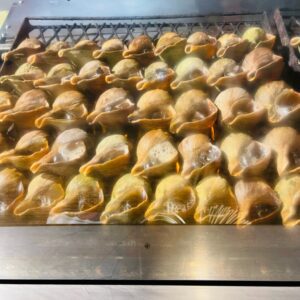

Five grilled whelks are placed on a special wooden board with an indentation to prevent the whelks from rolling off and served to the customers. The special wooden board is a custom-made product made of tamo wood. Tamo is a hardwood used for baseball bats. A bamboo skewer is used to remove the shellfish from the shell. However, if the last part, the liver, is not removed, the liver will slip out when the shell is struck against the wooden board. This is why they use hard Tamo wood.
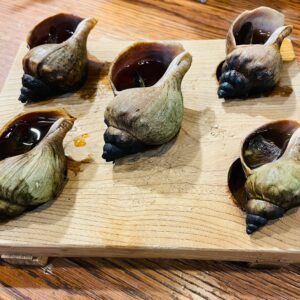
The hot whelks grilled with the secret sauce were truly exquisite and impressive. I think it was the best-grilled whelk I have ever tasted in my life. It is truly the taste of a restaurant specializing in grilled whelks.
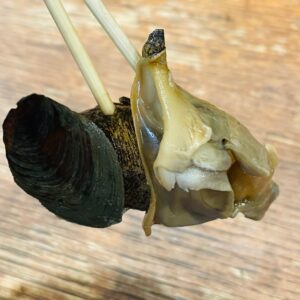
The ramen looked salty because of its black appearance, but in fact, it was not salty, but rather a gentle soy sauce flavor. It was not as impressive as the Tsubu-yaki (grilled whelks), but it was delicious enough.
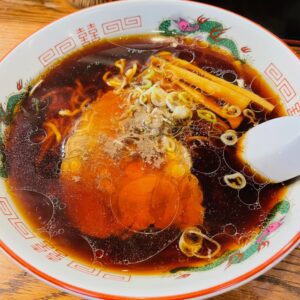
Tsubsu-yaki Kadoya was the perfect place to end a night of drinking. Of course, the restaurant was crowded with many customers. I have made up my mind to visit “Tsubsu-yaki Kadoya” on my next visit to Kushiro.

Important Points
If you are planning to visit Lake Akan, we recommend that you go directly from Kushiro Airport. It takes 1 hour and 15 minutes from Kushiro Airport to Lake Akan. On the other hand, it takes 2 hours from Kushiro Station to Lake Akan.
In addition, Kushiro Japanese Crane Reserve is located 8 minutes by bus from Kushiro Airport. It may be a good idea to visit Kushiro Japanese Crane Reserve first after arriving at Kushiro Airport. You can also take a bus from Kushiro Japanese Crane Reserve to Lake Akan. It takes about 1 hour and 5 minutes.
6. July 3 (Sunday) Day 2
I headed from Kushiro City to Akkeshi-cho to fully enjoy sightseeing in Akkeshi on July 3 (Sun.).
After arriving at Akkeshi Station, I immediately changed to a bus and headed for Kokutaiji Temple.
Kokutaiji Temple was built by the Edo Shogunate in 1804 and is one of the three official temples in Ezo. The other two are Usu Zenkoji Temple (Date City) and Samani Tojuin Temple (Samani Town). The three official temples in Ezo were intended to provide funeral rites for Japanese who died in Ezo (present-day Hokkaido) and to propagate Buddhism to the Ainu people. They were also meant as a check against the Russian Empire, which was trying to expand into Ezo and proselytize Christianity to the Ainu people.
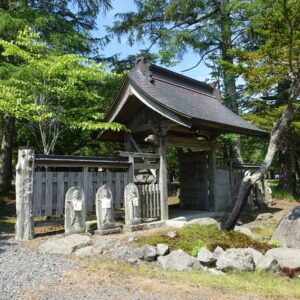
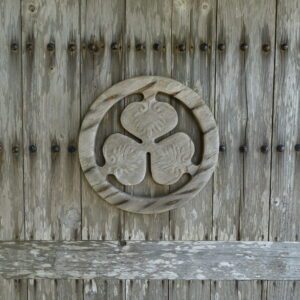
Kokutaiji Temple is designated as a national historic site. The garden in front of the main hall was magnificent. I strolled around slowly and found Kokutaiji to be a nice and atmospheric temple. On the gate of the temple, there was a carving of the wild ginger trefoil family crest of the Tokugawa clan, which indicates that the temple was established by the Edo Shogunate.
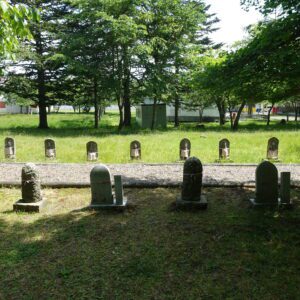
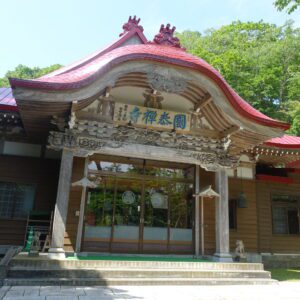
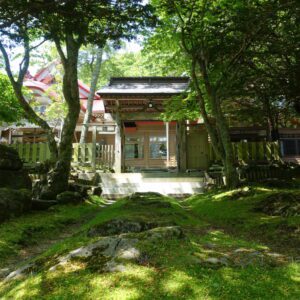
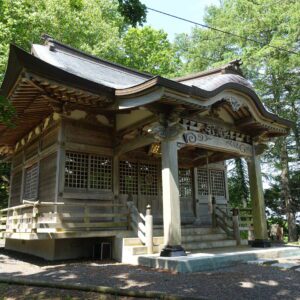
Right next to Kokutaiji Temple is the Akkeshi Shrine. Just on Sunday, July 3, when I visited, the annual festival was being held.
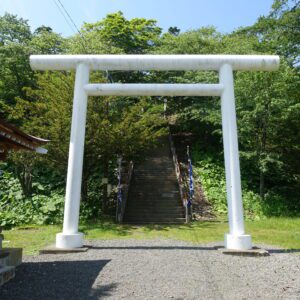
Akkeshi Shrine was founded by Tokunai Mogami in 1791. Tokunai Mogami traveled to Ezo nine times and was known as the greatest “Ezo connoisseur” of the Edo period (1603-1868). Tokunai Mogami was also a friend of Philipp Franz von Siebold, a German physician, and botanist.
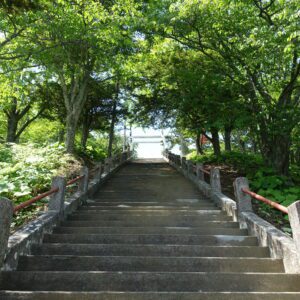
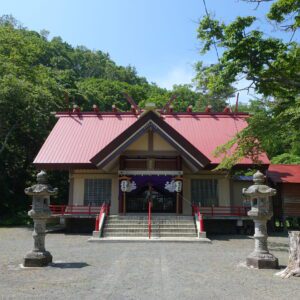
I walked from Kokutaiji Temple and Akkeshi Shrine to Shogyoji Temple. It took just over 10 minutes on foot.
Shogyoji Temple dates back to 1879 when the Otani sect of Jodo Shinshu established the Akkeshi Sermon Hall. The present main hall was dismantled from the main hall of Manchoji Temple (built in 1799) of the Jodo Shinshu sect in Itoigawa City and moved to the present location. The main hall is the only one of its kind in East Hokkaido and is a national important cultural property.
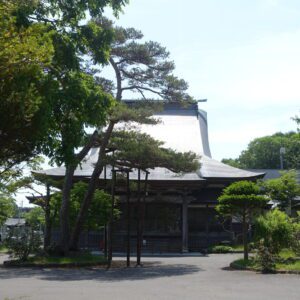
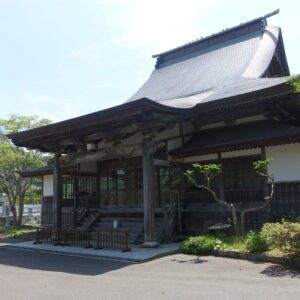
The bell tower of Shogyoji Temple was built in 1908. It is a national tangible cultural property.
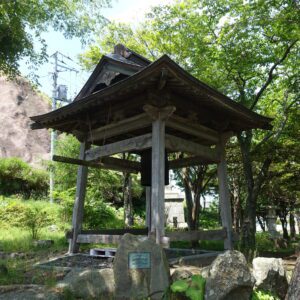
After visiting Shogyoji Temple, I took a cab to Conchiglie, the Akkeshi Taste Terminal. Conchiglie is the nickname of Michi no Eki (roadside station) Akkeshi Gourmet Park, which means “shell-shaped food” in Italian. The exterior of the facility is also designed in the image of oysters, a specialty of Akkeshi.
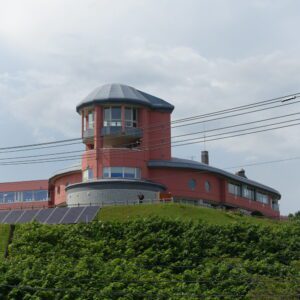

Conchiglie is a very popular roadside station, having received 89.9 points in the “Restaurants and Other Meals” category of the Roadside Station Ranking 2022 in the April issue of the travel magazine “Hokkaido Jalan” and has been ranked first for 12 consecutive years. It is built on top of a small hill, so the view from the conchiglie is very good.
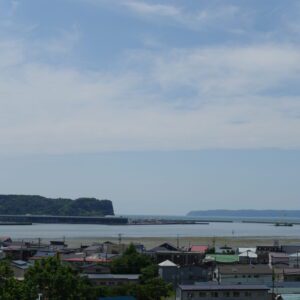
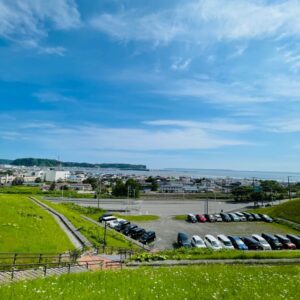
After having lunch at Conchiglie, I took a walk to the Akkeshi Ohashi Bridge. The Akkeshi Ohashi Bridge is 456.5 meters long. It was opened in 1972 as the first marine bridge in Hokkaido. The bridge spans the waterway bordering Lake Akkeshi and Akkeshi Bay.
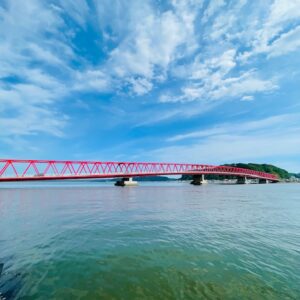
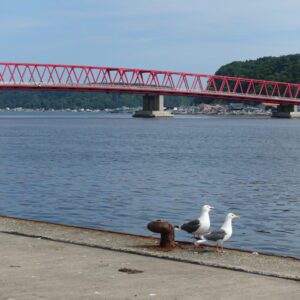
On Lake Akkeshi, where the Akkeshi Ohashi Bridge spans, there is an oyster island (officially Benten-Jima island) and a small Benten shrine.
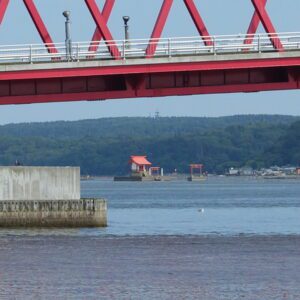
After enjoying a walk to the Akkeshi Ohashi Bridge, I returned to Kushiro Station from Akkeshi Station.
The train from Akkeshi Station to Kushiro Station was a Lupin the Third wrapping train. The author of “Lupin the Third”, Monkey Punch, is from Hamanaka-cho, Akkeshi-gun, which is located along the Nemuro Line (Hanasaki Line).



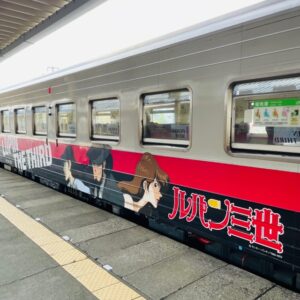
Returning to Kushiro, I took a short walk in Kushiro City. There is a large flower clock in Shidemai Park near the Nusamai Bridge. The clock is 10 meters in diameter and is decorated with about 1,300 flowers.
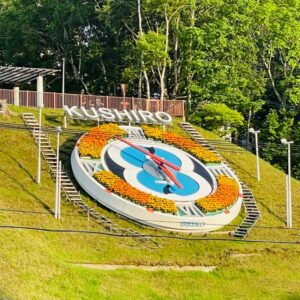
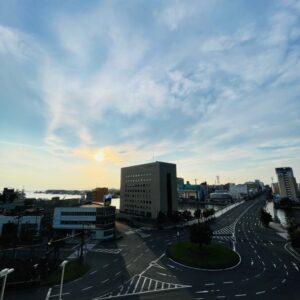
Kushiro is famous for sunsets. It is one of the “World’s Three Great Sunsets”. It is said that the higher the latitude, the deeper the angle of incidence of the sunset, resulting in a more beautiful sunset. The latitude of Kushiro is 43 degrees north. Bali Island in Indonesia and Manila in the Philippines were also selected as one of the “World’s Three Great Sunsets”. I would have liked to take pictures around Nusamai Bridge, but the timing of the sunset was around Kushiro Station. Still, the sunset was beautiful enough.

Meals
After finishing sightseeing in Akkeshi in the morning, I had raw oysters at Oyster Bar Pitresk in the Akkeshi Taste Terminal “Conchiglie” while drinking Akkeshi Whiskey. It is an alternative to a waiting bar before lunch.
“Oysters from Akkeshi” (season: May-August, December-February) are Hokkaido’s summer “PRIDE FISH” as selected by Japan Fisheries Co-operative. The year-round low sea water temperature in Akkeshi makes it possible to ship oysters year-round. There is an island called Oyster Island (officially Benten Island) in Lake Akkeshi where oysters are cultivated.

The whisky produced at the Akkeshi Distillery is also a specialty of Akkeshi. Akkeshi Distillery started distilling whisky in October 2016 with a strong desire to “make whisky like Islay malt using traditional Scottish methods. Two years after the start of whisky distillation, the first product was sold in 2018, and in 2021, it won the World Whisky Award 2021. Thus, Akkeshi Distillery is a fast-growing distillery that is attracting attention around the world.
The counter seating at Oyster Bar Pitresk had a great view, and I enjoyed the trinity of the best oysters, the best whiskey, and the best view. I highly recommend this Oyster Bar.
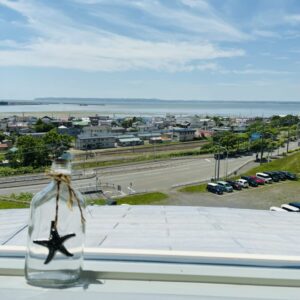
After enjoying the best oysters and whiskey at Oyster Bar Pitresk, I had a sumptuous charcoal barbecue lunch at “Charcoal Grill Aburiya” in Conchiglie. At the seafood market adjacent to Charcoal Grill Aburiya, one can purchase oysters and other seafood, meat, and vegetables, which are then grilled over charcoal. There are more than 70 different ingredients to choose from at the seafood market.
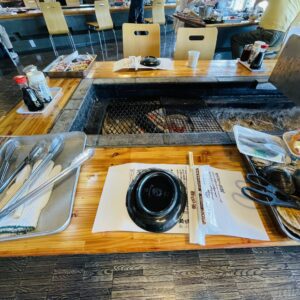
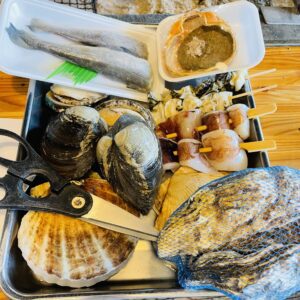
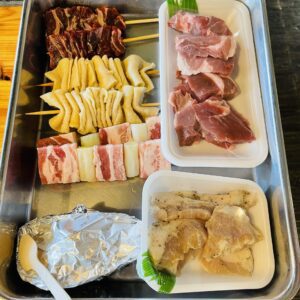
The most delicious dish of the day was the Sakhalin surf clam. I think the Sakhalin surf clam I had at “Charcoal Grill Aburiya” was from the eastern part of Hokkaido, as it was listed on the menu. They were thick, sweet, and irresistibly delicious.





The soba noodle restaurant I visited was called “Azumaya Kawakita Branch”. It is a branch of “Chikuroen Azumaya Sohonten (Main restaurant),” a long-established soba noodle restaurant in Kushiro, which was founded in the Meiji Era. There are many Azumaya branch restaurants in Kushiro.
I ordered Muryouju Soba. Muryouju Soba is a local delicacy in Kushiro. It was developed by “Chikuroen Azumaya Sohonten”. I thought it might be oily because of the sesame oil, but it was delicious and not oily at all.

Important Points
The Lupin the Third Wrapping Train makes one and a half round trips a day mainly between Kushiro and Nemuro. However, there are days when the train service is changed to the Kushiro-Abashiri route, or there is no service at all, so it is necessary to check the JR Hokkaido schedule.
Kushiro Station is the terminal station of the limited express “Oozora” train that runs to and from Sapporo Station. In addition, quite attractive ”Ekiben” such as “Taraba Gani (King crab) Chirashi”, “Kaki-ben (Oyster-bento)”, and “Hanasaki Kani-meshi (Blue king crab bento)” are sold there. It was impressive that all the ekiben sold in large quantities in the morning were sold out by the evening.
7. July 4 (Monday) Day 3
On the last day of my trip to Kushiro and Akkeshi, I went to Kushiro Marshland by “Kushiro Shitsugen Norokko-go“.
The “Kushiro Shitsugen Norokko-go” has unreserved seats in Car No. 1 and reserved seats in Cars No. 2 to 4. Cars No. 2 to 4 are observation cars with large windows, so you can fully enjoy the view of Kushiro Marshland. The observation car (reserved seat) costs Yen 530 in addition to the fare, but it is worth it.
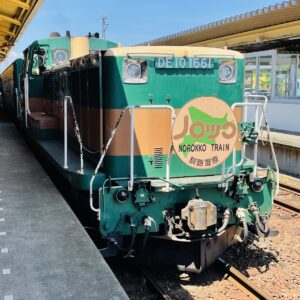
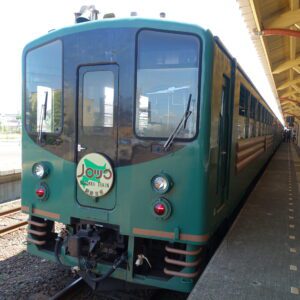
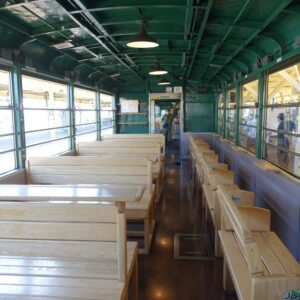
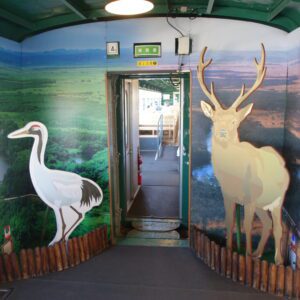
On the way to Kushiro Shitsugen Station, you will find “Iwaboki-suimon (Iwabokki Water Gate). This water gate was built to prevent flooding of the Kushiro River that flows through the Kushiro Marshland. The old water gate was completed in 1931 and the new one in 1990. The photo shows the new water gate.
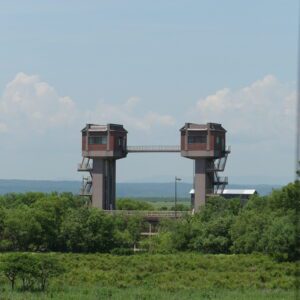
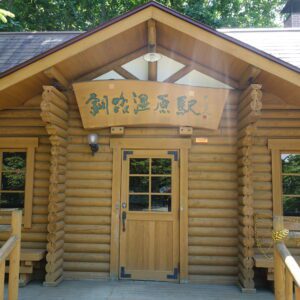

Hosooka Observatory was selected by TripAdvisor as the “Travelers’ Choice! Japanese people’s Favorite Observatories & Parks Ranking 2020” in observatory category No.1. You can enjoy a spectacular view of Kushiro Marshland.
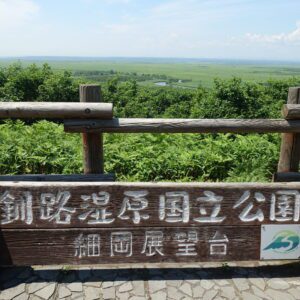
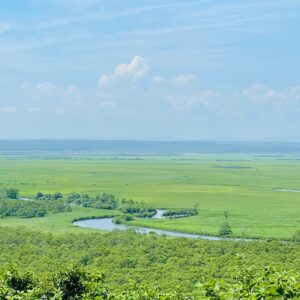
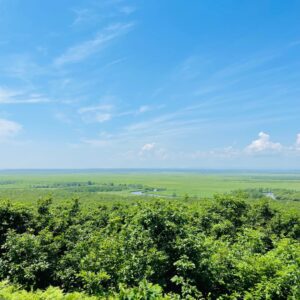
After having an excellent lunch in Kushiro city, I took a bus to Kushiro Japanese Crane Reserve.
Crane Park is located near Kushiro Airport, so it is recommended to visit there after arriving or before departing from Kushiro Airport by plane. The park was very enjoyable, as you can see many Japanese cranes up close. The Japanese cranes are a nationally protected species (a special national natural treasure).

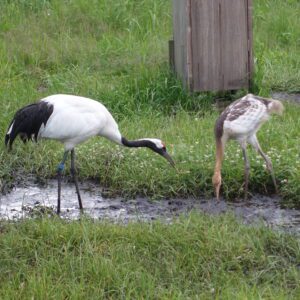
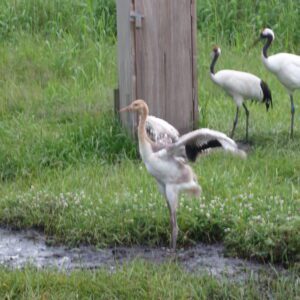
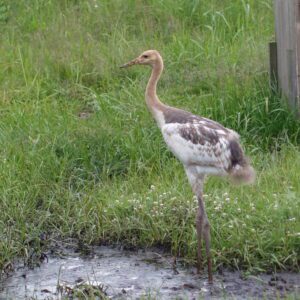
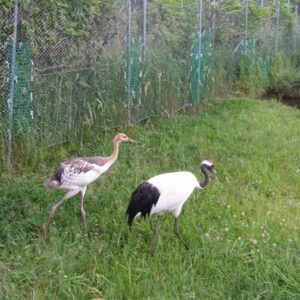
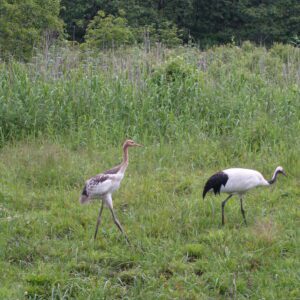
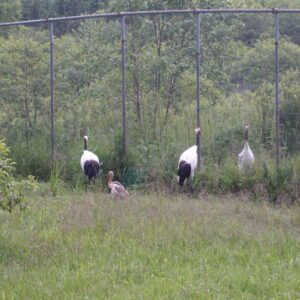
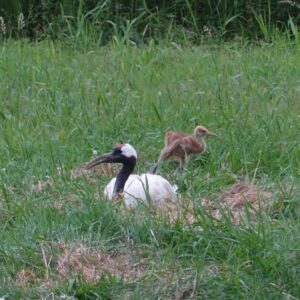
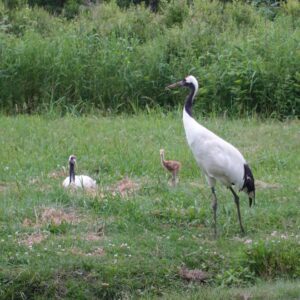

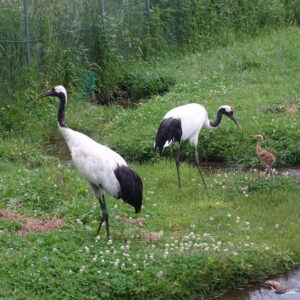
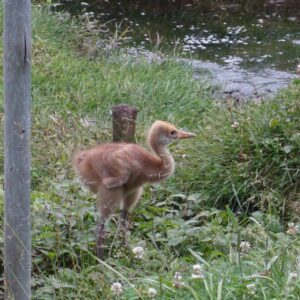
 Meals
Meals
On the last day of my trip, I had Shoyu (soy sauce) ramen for breakfast at Kushiro’s most popular ramen restaurant, Ramen Maruhira. Ramen Maruhira has been in business since 1959.
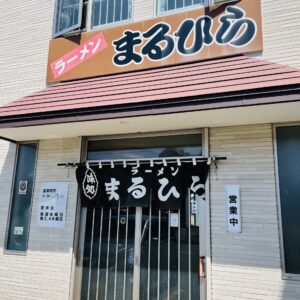
Ramen Maruhira offers only shoyu ramen and shio ramen. However, there are three sizes available: regular, large, and extra-large. The prices are Yen 700, Yen 800, and Yen 900, respectively. There is no beer or other alcoholic beverages, probably because the restaurant is not open at night.
I ordered the regular shoyu ramen. Some of the regular customers ordered shio ramen.

Ramen Maruhira’s soy sauce ramen looked ordinary, but when I drank the soup, I found a very deep flavor. The soup seemed to be made of bonito and other seafood. The noodles are thin and curly and go well with the soup. The long, thin bamboo shoots and the small but thick and tasty cha shu pork also matched the soup very well.
The ramen was very well done, and I could understand why it is the most popular ramen restaurant in Kushiro. It was one of the top three soy sauce ramens I have ever had. I finished off the noodles and the soup as well.
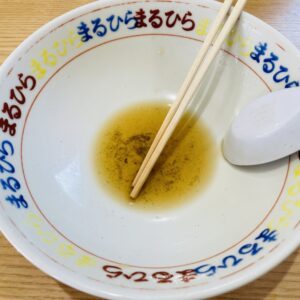
After the Kushiro Wetlands tour, I had “Spag-Katsu”, a local dish of Kushiro, for lunch at Restaurant Izumiya in downtown Suehiro-cho, Kushiro City. “Spag-Katsu” is a pork cutlet topped with spaghetti in meat sauce. It seems that the dish was first served on a teppan plate so that it would not get cold even in the cold Kushiro. Restaurant Izumiya is the birthplace of “Spag-Katsu”.
Restaurant Izumiya is a long-established Western-style restaurant established in 1959. Restaurant Izumiya” started serving “Spag-Katsu” around 1960, shortly after its establishment.
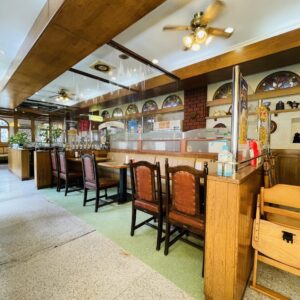
The meat sauce of the “Spag-Katsu” has a mild and nostalgic taste. The pork cutlet is also very tasty, with the nostalgic pork cutlet taste of a Western-style restaurant.

The “Spag-Katsu” at Restaurant Izumiya was very tasty, and I was glad I had it. For some reason, I felt very happy after eating the “Spag-Katsu”.
After enjoying viewing the cute chicks of Japanese (tancho) cranes at the Kushiro Japanese Crane Reserve, I had dinner at “Restaurant Tancho” at Kushiro Airport.
At Restaurant Tancho, I ordered Jingisukan, Tako-Zangi, and chilled tomatoes.
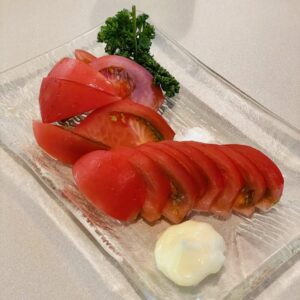
“Jingisukan” is one of Hokkaido’s representative local dishes. It was first listed as a representative dish of Hokkaido in the “100 Best Local Dishes” selected by the Ministry of Agriculture, Forestry and Fisheries of Japan.

“Zangi” is usually deep-fried chicken, but “Tako-Zangi” is a deep-fried octopus. “Zangi” is said to have originated around 1955 when Torimatsu, a yakitori restaurant in Suehiro-cho, Kushiro City, chopped a whole chicken into pieces and deep fried it. “Zangi” is characterized by the fact that the chicken is marinated in a sweet and spicy soy sauce-based sauce before frying. “Zangi” has been selected as one of the “Our Regional Cuisines” of Hokkaido by the Ministry of Agriculture, Forestry and Fisheries of Japan.

Important Points
“Kushiro Shitsugen Norokko-go” has two types of seats in the observation car (reserved seats): box seats and bench seats for two. Bench seats are located on the right side of the train in the direction of travel, at right angles to the window, so they offer a better view of the scenery. However, it is the box seats that offer the best view of Kushiro Marshland. Box seats are for six passengers, so if the train is crowded, there will be sharing seats.
Japanese cranes have a fixed egg-laying schedule: they lay eggs in April and May, and the parent cranes hold the eggs for 32 days before chicks are born. Therefore, many chicks are born in May and June. late May to early July is the best time to see the chicks.
Note: The departure/arrival times, fares of transportation, admission fees, meal fees, etc. listed in the text are as of the time of writing the BLOG. Please check for yourself when you go on a trip as it may change in the future.
